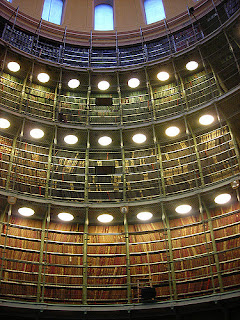 |
| http://parkslibrarypreservation.files.wordpress.com/2011/05/conservation-lab1.jpg |
The conservation lab lives in a separate building from the rest of the library. There are five teams of conservators and the entire sixth floor is devoted to working with and conserving paper items such as maps, wall hangings, miniatures and archives.
The majority of the work done here is on books. But there is also work being done on items such as stamps and photographs. Some examples of work that has been conserved include a collection of first edition Beatrix Potter bindings and Codex Formaticus which was broken into pieces.
Any item that is conserved has an extremely detailed conservation record where the conservators describe EVERY action taken with the item including an inventory of materials used such as adhesives and papers.
One of the conservators was working on conserving a 17th century palm leaf book with a 14th century text inscribed on the leaves. There are 253 leaves in total and each leaf bound together by a thread that goes through the middle of the leaf. Many of the leaves have been damaged and pieces of the leaf have been broken off. These leaves are difficult to work with because traditional adhesives don’t work. The leaves have been treated with oil and this makes the adhesives ineffective. Since the edges of the leaves cannot be repaired in a traditional manner, the conservator employed a piece of equipment called a leaf caster. I wasn’t able to see this machine but it sounds very interesting. Essentially, a mold of the leaves is made; a paper pulp is made and then pressed through the mold onto the leaf, filling in the missing spaces.
One of the conservators gave a demonstration on gold tooling. Having done golf tooling once before, I was fascinated to see it done again. First, the leather is polished using a warm metal tool; this smooths out the surface of the leather, leaving a polished surface for the gold to be impressed into. Then a mild adhesive consisting of egg white and water is put in the leather followed by a thin layer of Vaseline which makes the gold stick to the spine. Using a thread, the conservator made a small line to make sure the line of text would be straight. Then using a hot tool, the gold is impressed into the spine. Only where the hot tool has touched will there be any gold. It is a very delicate process. The conservator said he had apprenticed doing this kind of work for five years before he started his career. Very impressive.
The kind of work being done in the labs is so fascinating to me and I am so grateful for having the opportunity to see these dedicated people at play.
*The amazing display cap above is by Jessica Hische, an amazing designer I came across in my perpetual search for awesome design and typography. The letter comes from her Daily Drop Cap project.










